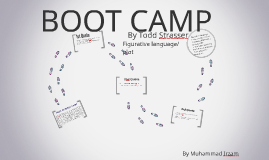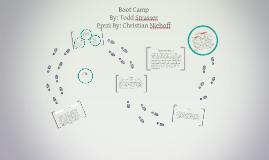BOOT CAMP
Transcript: 1st Quote PLOT OF BOOT CAMP 2nd Quote A fifteen year old boy named Garrett is picked up by a pair of bounty hunters and sent to a boot camp in upstate New York called Lake Harmony. Upon his arrival, he learns that his parents have sent him to the facility because he refused to stop having intimit relationships his former math teacher, Sabrina, along with other things including staying out too late, and smoking marijuana. Garrett is an incredibly bright and clever kid. His parents are, at most, distant. Garrett does not believe he belongs at Lake Harmony, but he is not allowed to leave until he has admitted his "mistakes" and conforms to the facility's standards of behavior. Staff members are authorized to use "any force necessary" to alter his behavior, including physical and psychological abuse. After attempting to talk his way out with no success, he realizes escape is his only option. He escapes Lake Harmony with two friends, Pauly and Sarah, after using chemicals to start a fire. They reach the Canadian border to escape from legal recapture, and their pursuers' boat begins to sink. He lets his friends out on the other side of the border, and then rescues his pursuers, who bring him back to Lake Harmony, where he is beaten senseless repeatedly. The director announces that all campers are being demoted, based on the privilege system they use, and to blame Garrett, so he is beaten yet again by the campers. Ultimately, he is "reformed". He begins to believe in the treatment, feeling no remorse when those around him are abused. When his mother comes to pick him up with an investigator, the investigator asks if he was beaten. He breaks down and says that he was, but is still scared of what Lake Harmony would do to him. This forced him to say that he deserved all of it, since the director was standing there. It is possible that these events caused him to suffer from PTSD, as he appears to suffer from a mental breakdown when admitting what has occurred. "The potholes are getting bigger, and we toss and heave like a boat on rough seas"(Strasser 4) Analysis: The ride is very bumpy as being compared to a boat on rough seas using a simile. "The chatter of crickets is almost as loud as traffic on a city street"(Strasser 5). Analysis: There are so many crickets that make it feel like a busy street in the middle of a city. Figurative language/plot "The air is cool and smells like pine"(Strasser 5). Analysis: The air is very chilly and smells very pleasant. BOOT CAMP Figurative language plays a central role in the piece of literature. It makes the publication realistic. It blends the transitions throughout the bestseller. By Muhammad Irzam By Todd Strasser 3rd Quote

















